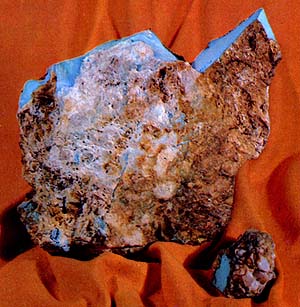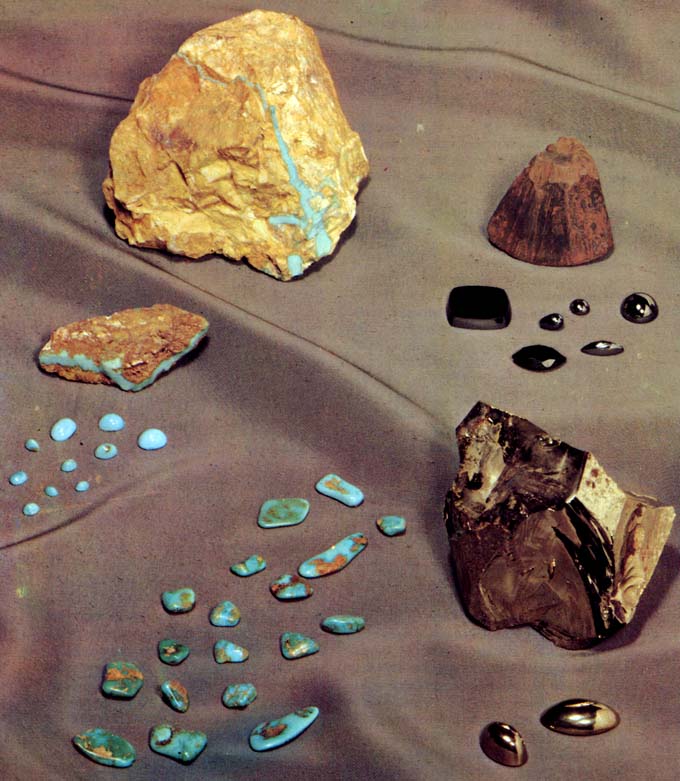Turquoise - blue and green precious stone of the East
 Turquoise
Turquoise
On the picture. Turquoise. Middle Asia.
Chemical formula: CuAl6 x [PO4] 4 [OH] 8 x 5H2O.
The chemical composition is unstable. In the process of aging and replacement by secondary minerals, the role of oxide iron, silica, calcium, magnesium, zinc, strontium increases.
Chemical composition (in%): CuO 9.57, Al2O3 36.84, P2O5 34.12, H2O 19.47. Constant impurities - sulfur, zinc, barium, chromium, nickel, titanium, etc.
Singonia: triclinic.
Microcrystalline masses of the kidney-like form are common, or in the form of crusts, veins, and irregularly shaped clusters.
Color: sky-blue, bluish-green to apple-, greyish- and brownish-green hues. The blue turquoise color is characteristic for turquoise weathering unaffected by weathering, depends on the copper content. Greenish, brownish and other tones are due to the iron oxide replacing copper in the zone of its intensive decomposition.
The admixtures of halloysite, kaolinite and wavellite give whitish spots.
Often turquoise contains inclusions of quartz, pyrite and other minerals.
Hardness: 5-6; Decreases to 2-4 for weathered specimens, brittle.
Density: 2.8-2.9 g / cm3 in dense specimens, 2.6 g / cm3 in weathered specimens.
Fracture: shell. Glitter: waxy, after polishing - glass.
Transparency: opaque, thinly cleaved.
Light refraction: ng = 1.65, nm = 1.62, np = 1.61.
Dispersion: strong.
Turquoise has been used since ancient times - stones of rough processing of Aztecs, jewelry with turquoise from the tombs of Egyptian pharaohs, stone-cutting hand-made articles by Chinese masters, magnificent adornments from turquoise peoples of Asia - and up to the present time. Deposits of turquoise in Central Asia, in the Kuramin and Chat-kal ranges are associated with quartz-vein zones of the porphyry formation (Biryuzakan, Ungurlikan, Tashtepe) and are characterized by high quality raw materials. In carbonaceous-quartz-siliceous formations in the range. Sultanuizdag and in Kyzyl-Kum there are deposits with a considerable number of weathered varieties of turquoise.
Of interest are congestion of turquoise, associated with copper-molybdenum deposits in Central Asia (Kylmakyr) and in Armenia (Teghout). Here turquoise develops in the areas of clarification and silicification in the form of crusts, primaques painted in greenish-blue tones. At the same time, dense bright-colored differences of blue and greenish-blue hue are noted with depth. Particularly valuable is the dense, partially translucent edge of turquoise, which has a bright sky and greenish-blue color, without any impurities and foreign inclusions, as well as signs of weathering. In the Central Asian deposits, it occurs in the form of inclusions up to 2, rarely 5 cm in diameter in gum (nuggets), weathered host rocks or thin veins (2-5 mm, rarely up to 2 cm) among weathered turquoise. It is a small (rarely 10-20) percent of the total reserves.
Differences of turquoise bluish, greenish hues, somewhat less hardness and density, with spots and inclusions are widespread. They are appreciated much lower. Turquoise forms precipitates ranging in size from millimeters to several centimeters and a length of 1-9 m, as well as nestlike clusters of 10-20 cm. A large turquoise lens weighing 4.5 kg was found on the Biryuzakan deposit, some parts of which are composed of high quality turquoise.
Formations of weathered turquoise with a mass of up to 1 kg and more occurred in the deposits of Kyzylkum and South Kazakhstan. Varieties of turquoise with thin veins of black carbonaceous material or iron oxides in bright blue tone, extracted in Kyzylkum, are called "arachnids" or "netted" and are in great demand.
Turquoise is easy to process, it takes a mirror polish. Cabochons are made of round or oval shape. Turquoise is used in jewelry in combination with pearls, diamonds and other gems. Some researchers attribute turquoise to hydrothermal low-temperature formations; Others - to the hypergenic products of weathering crusts of rocks enriched with phosphorus, copper, organic residues. Currently, the open (career) method of turquoise deposits is being worked out in Central Asia, Armenia.

Turquoise, hematite-bloodstone, pyrite. Central Asia, Kazakhstan.
Popular gems, which are represented on the territory of the CIS (former USSR)
- Diamond is the hardest and one of the most expensive minerals in the world
- Alexandrite (chrysoberyl) - one of the rarest and original stones
- Beryl (group of beryl) - heliodores, emeralds, aquamarines, morganites
- Turquoise - blue and green precious stone of the East
- Granat (group of pomegranates) - popular inexpensive gems
- Jadeite is a popular stone used in the Neolithic
- Pearls - traditional and favorite decoration of the Slavs
- Quartz (a group of quartz) is an extremely popular mineral in collections
- Corundum (group of corundums) - colorless corundums, rubies and sapphires
- Lazurite - blue stone of the high blue mountains of Pamir and Afghanistan
- Malachite - the Ural malachite is considered the best in the world
- Jade is the sacred green stone of Chinese emperors
- Feldspars - Labrador, Moonstone, Sun Stone, Amazonite
- Rodonit (orlez) - a beautiful pink stone of the Urals, a stone of Russia
- Topaz - blue, yellow, wine and polychrome minerals
- Tourmaline - original gems of all colors and shades
- Fluorite is a valuable mineral used in industry
- Chrysolite - magmatic mineral, transparent garnet olivine
- Spinel was relatively recently identified as an independent class
- Amber (fossil pitch of ancient trees) - frozen time
- Jasper - an unusual mineral with a wide palette of coloring


Comments
When commenting on, remember that the content and tone of your message can hurt the feelings of real people, show respect and tolerance to your interlocutors even if you do not share their opinion, your behavior in the conditions of freedom of expression and anonymity provided by the Internet, changes Not only virtual, but also the real world. All comments are hidden from the index, spam is controlled.